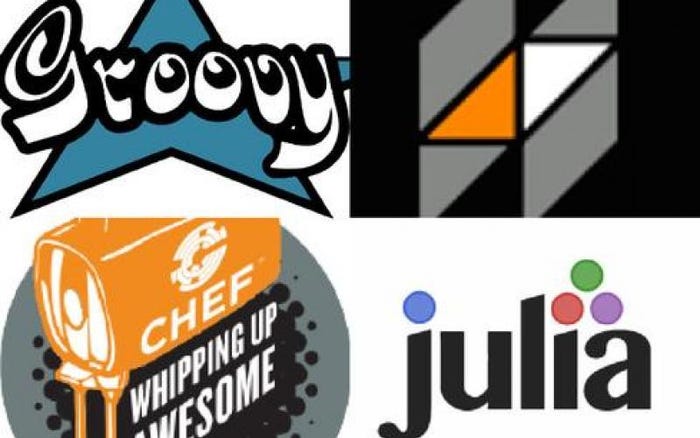12 Hot Programming Languages To Learn
With the growing software-defined networking trend, networking pros are under pressure to learn some coding. Here are a dozen programming languages worth checking out.
September 25, 2016

For many, or most, programmers, a simple “hello, world” changed their lives when they were young. Networking and infrastructure professionals often don’t share that same zeal. Of course, many are being pressured to learn coding, if for no other reason than to automate simple repetitive processes.
The growth of software-defined networks has certainly given more strength to the push, and the fact that many networking pros have already discovered ways to automate seems irrelevant. While the argument isn’t likely to be settled here, there are quite a few recent shifts in programming philosophy that even the most insulated networking pro might find interesting.
Want to learn to code? Attend the live workshop Python for Networking Pros at Interop Las Vegas this spring. Don't miss out! Register now for Interop, May 2-6, and receive $200 off.
Python
A venerable dynamic language, Python is focused on readability -- and whimsy. The name itself is derived from famed sketch comedy troupe Monty Python. The high-level dynamic language is best suited for scripting, but still seems to find new off-label uses years after its first stable release. Its simplicity and speed have influenced other languages, ranging from OCaml to Groovy.
Chef & Puppet
Both primarily known chiefly as automation platforms, Chef and Puppet programming languages offer ideal learning opportunities for networking pros seeking to dip into programming for the sake of making their jobs easier. Both languages facilitate the code-as-infrastructure philosophical shift, with their related platforms most commonly used to deploy servers and applications, keeping flexible as to location and size of the infrastructure. While Puppet still has a much larger user base and is officially supported on a higher number of operating systems, Chef is gaining traction with mega-companies like Google and Amazon.
Apple created a lot of buzz at WWDC 2014 when it introduced Swift, its new programming language designed for iOS and OS X development. With Swift, Apple has essentially taken a familiar standby, Objective-C, and removed many of the cumbersome elements carried over from C. Among the benefits, the company is most aggressively touting the addition of generic programming and an end to pointers.
Hack
When Facebook needed better performance, greater efficiency and more robust security for its HHVM, it rolled out Hack. The open source programming language is, at root, a new version of PHP -- to the point that many would deny that it actually is a new language after all. Hacks main innovation is gradual-typing, which allows some parts of a program to be dynamically typed while others are statically typed. The move should allow for greater interoperability and programming speed. Facebook points to its own dogfooding as an example. Its currently used to run the busiest social network in the world.
Dart
Google engineers went gunning for JavaScript and the weapon they developed was Dart. The language is dynamically typed, like JavaScript, but also adds optional type annotations and user-defined operator methods while removing prototypes and the global object. In this way and others, Google hopes to create a faster and more reliable platform for web app development.
Ceylon
Ceylon is an object-oriented programming language built by Red Hats Gavin King to correct certain shortcomings of Java. Fundamentally, the language is meant to facilitate writing large programs across different teams. Programs execute on both Java and JavaScript virtual machines and interoperate with native code. The type system is based around intersection and union types, as well as enumerated types and type aliases.
Opa
Opa is a framework for JavaScript, intended to be used to develop scalable web applications. Opa allows the programmer to write frontend and backend code simultaneously, compiling to JavaScript to Node.js on the server side and jQuery on the client side. The languages designers believe that its unique structure will help defend against SQL injection and XSS attacks. Opa is licensed under the MIT license structure, so it can be used in proprietary projects or distributed as open source.
Rust
When Mozilla set out to create its next big browser, Servo, it realized that C++ wasnt up to the job. The companys solution was the creation of Rust, a multi-paradigm language focused around isolation, concurrency execution and memory safety. In fact, memory allocation is one of the languages main concerns, offering the developer tight control through contiguous records and stack allocation. At present, there is no due date for the 1.0 release, but the curious are invited to compile preview release 0.10.
Elm
For highly interactive games and web applications, Elm is a language to watch. The functional reactive language offers first-class functions, immutability and type inference. Code compiles to HTML, CSS and JavaScript. The syntax borrows heavily from Haskell with a sprinkling of OCaml. While the project is still a few steps away from beta, an online editor allows you to write and compile code online.
Elm
For highly interactive games and web applications, Elm is a language to watch. The functional reactive language offers first-class functions, immutability and type inference. Code compiles to HTML, CSS and JavaScript. The syntax borrows heavily from Haskell with a sprinkling of OCaml. While the project is still a few steps away from beta, an online editor allows you to write and compile code online.
For many, or most, programmers, a simple “hello, world” changed their lives when they were young. Networking and infrastructure professionals often don’t share that same zeal. Of course, many are being pressured to learn coding, if for no other reason than to automate simple repetitive processes.
The growth of software-defined networks has certainly given more strength to the push, and the fact that many networking pros have already discovered ways to automate seems irrelevant. While the argument isn’t likely to be settled here, there are quite a few recent shifts in programming philosophy that even the most insulated networking pro might find interesting.
Want to learn to code? Attend the live workshop Python for Networking Pros at Interop Las Vegas this spring. Don't miss out! Register now for Interop, May 2-6, and receive $200 off.
About the Author(s)
You May Also Like





